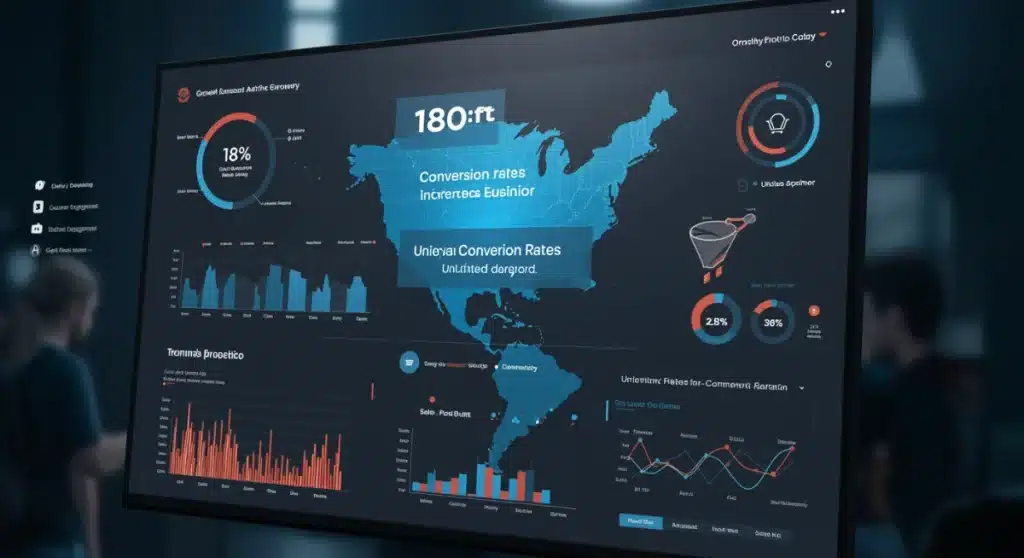Boost E-commerce Conversion Rates 18% in 2025: U.S. Digital Strategy

Achieving an 18% boost in e-commerce conversion rates by 2025 in the U.S. market requires a focused digital strategy integrating advanced analytics, personalized customer experiences, and optimized mobile interfaces for significant financial impact.
Boosting E-commerce Conversion Rates by 18% in 2025: A U.S.-Specific Digital Strategy Guide (FINANCIAL IMPACT) is no longer just an ambitious goal; it is a critical imperative for businesses navigating the competitive U.S. digital economy. This guide outlines the timely strategies and tactical shifts necessary to achieve substantial growth and financial returns, focusing on verified data and actionable insights for today’s market.
Understanding the Current U.S. E-commerce Landscape
The U.S. e-commerce market continues its robust expansion, but conversion rates remain a persistent challenge for many retailers. As of early 2024, the average conversion rate hovers around 2-3%, indicating a vast untapped potential for optimization. Businesses failing to adapt to evolving consumer behaviors and technological advancements risk stagnation in a rapidly moving digital space.
Recent reports from industry analysts confirm that U.S. consumers are increasingly discerning, demanding not just competitive pricing but also highly personalized experiences and seamless interactions across all touchpoints. This environment makes a targeted approach to ecommerce conversion strategy more critical than ever. The financial implications of even a slight increase in conversion rates are significant, directly impacting revenue, customer lifetime value, and market share.
Key Trends Shaping U.S. E-commerce
- Mobile-First Shopping: A majority of e-commerce traffic now originates from mobile devices, yet many sites still struggle with mobile optimization.
- Personalization Demand: Consumers expect tailored product recommendations, dynamic content, and relevant offers based on their browsing history.
- Data-Driven Decisions: Businesses are increasingly leveraging advanced analytics and AI to understand customer behavior and predict future trends.
Understanding these foundational elements is the first step toward building a strategy that can genuinely deliver an 18% boost in conversion rates. The market is ripe for those willing to invest in sophisticated digital tools and customer-centric approaches.
Leveraging Advanced Analytics for Conversion Insights
To significantly enhance e-commerce conversion rates, businesses must move beyond basic website traffic metrics and delve into advanced analytics. This involves not only identifying where potential customers drop off in the sales funnel but also understanding the ‘why’ behind those actions. Tools that offer heatmaps, session recordings, and A/B testing capabilities are indispensable for this deep dive.
For U.S. businesses, sophisticated analytics platforms can pinpoint regional preferences, device-specific issues, and even micro-segments of customers exhibiting unique behaviors. This granular data allows for highly targeted interventions, transforming generic strategies into precision-guided campaigns designed to maximize financial impact. The goal is to identify bottlenecks and friction points that deter conversions.
Implementing a Robust Analytics Framework
- Funnel Analysis: Map out the entire customer journey from landing page to purchase confirmation to identify exact drop-off points.
- Behavioral Tracking: Utilize tools like Google Analytics 4, Hotjar, or similar platforms to monitor user interactions, clicks, scrolls, and form submissions.
- A/B Testing: Continuously test different versions of landing pages, product descriptions, call-to-actions, and checkout flows to optimize for higher conversions.
By systematically analyzing and acting upon these insights, U.S. e-commerce businesses can make data-backed decisions that directly contribute to achieving an 18% increase in conversion rates by 2025. This proactive approach ensures resources are allocated effectively to areas with the highest potential for improvement.
Optimizing User Experience (UX) and User Interface (UI)
A compelling user experience and intuitive user interface are paramount for any successful ecommerce conversion strategy. In the U.S. market, consumers have high expectations for website performance, ease of navigation, and visual appeal. A clunky or confusing interface can quickly lead to abandonment, regardless of product quality or pricing.
Focusing on mobile responsiveness is no longer optional; it’s a fundamental requirement. With a significant portion of U.S. online shopping occurring on smartphones, websites must be designed first and foremost for mobile devices, ensuring fast loading times, clear visuals, and effortless navigation. This optimization directly contributes to a smoother customer journey and, consequently, higher conversion rates.
Core UX/UI Enhancements for 2025
Improving navigation and site search functionality is crucial. Customers need to find what they’re looking for quickly and efficiently. Implementing predictive search, clear category structures, and prominent filtering options can drastically reduce frustration and guide users toward conversion. Product pages must be rich in detail, high-quality images, and authentic customer reviews, providing all necessary information for an informed purchase decision.
The checkout process, often a major pain point, requires relentless optimization. Reducing the number of steps, offering guest checkout options, and ensuring transparent pricing (including shipping and taxes upfront) can significantly decrease cart abandonment rates. For U.S. consumers, trust signals such as secure payment badges and clear return policies are also vital.
Finally, visual design plays a critical role. A clean, modern aesthetic that aligns with brand identity not only builds trust but also makes the shopping experience more enjoyable. Consistent branding across all digital touchpoints reinforces credibility and professionalism, encouraging repeat visits and purchases. These UX/UI improvements are foundational to achieving an 18% conversion rate increase.
Personalization and Customer Journey Mapping
Personalization is no longer a luxury but a core expectation for U.S. e-commerce shoppers. A truly effective ecommerce conversion strategy in 2025 must involve mapping out the entire customer journey and injecting personalized elements at every stage. This extends beyond simple product recommendations to dynamic content, targeted promotions, and individualized communication.
Understanding diverse customer segments within the U.S. is key. What appeals to a shopper in New York might differ significantly from one in Texas or California. Leveraging CRM data, browsing history, and purchase patterns allows businesses to create highly relevant experiences that resonate with individual preferences, thereby increasing engagement and conversion probability. This level of tailored interaction fosters a sense of value and understanding.
Strategies for Hyper-Personalization
- Dynamic Content: Display different homepage banners, product categories, or promotions based on a user’s past interactions or demographic data.
- Personalized Product Recommendations: Utilize AI-powered engines to suggest products based on viewing history, purchase history, and items viewed by similar customers.
- Targeted Email Marketing: Send personalized emails with abandoned cart reminders, back-in-stock notifications, or exclusive offers relevant to the individual’s interests.
By meticulously mapping the customer journey and implementing hyper-personalization, U.S. e-commerce businesses can create a more engaging and efficient shopping experience. This strategic focus ensures that each customer feels uniquely understood and valued, driving them closer to conversion and contributing substantially to the 18% target.

Optimizing Mobile Commerce and Performance
Mobile commerce is the undeniable powerhouse of U.S. e-commerce, and its optimization is critical for any strategy aiming to boost conversion rates by 18% by 2025. A seamless and high-performing mobile experience is no longer a competitive advantage; it’s a basic expectation. Slow loading times, difficult navigation, and non-responsive designs on mobile devices are guaranteed conversion killers.
Businesses must prioritize mobile-first design principles, ensuring that their e-commerce platforms are built from the ground up to cater to smartphone and tablet users. This includes implementing Accelerated Mobile Pages (AMP) or progressive web apps (PWAs) to deliver lightning-fast experiences. The financial impact of a poorly performing mobile site is immediate and measurable, leading to high bounce rates and lost sales.
Key Mobile Optimization Tactics
Reducing page load times is paramount. Every second counts in mobile commerce; even a small delay can deter a potential customer. Optimizing images, leveraging browser caching, and minimizing code are essential steps. Furthermore, ensuring that all clickable elements are appropriately sized for touch interaction and that forms are easy to complete on a small screen dramatically improves the mobile user experience. Simplicity and speed are the guiding principles for mobile optimization.
Implementing one-click purchasing options and integrating popular mobile payment methods like Apple Pay or Google Pay can significantly streamline the checkout process. For U.S. consumers, convenience is a key driver, and reducing friction during payment can directly translate into higher conversion rates. Regularly testing the mobile site across various devices and operating systems is also crucial to identify and rectify any performance issues before they impact sales.
Ultimately, a superior mobile experience is a cornerstone of a successful ecommerce conversion strategy. By focusing on speed, usability, and convenience, U.S. retailers can capture a larger share of the mobile shopping market and move closer to their 18% conversion rate goal.
Building Trust and Credibility in the Digital Space
In a competitive U.S. e-commerce market, building trust and credibility is fundamental to increasing conversion rates. Consumers are increasingly wary of online scams and unreliable retailers. A robust trust strategy can significantly influence purchasing decisions and contribute to the targeted 18% conversion boost.
Transparency is key. Clear communication regarding product details, pricing, shipping costs, and return policies instills confidence. Hidden fees or unclear terms can quickly erode trust and lead to cart abandonment. For U.S. shoppers, readily accessible customer service options, such as live chat or phone support, also signal reliability and a commitment to customer satisfaction.
Essential Trust-Building Elements
- Secure Payment Gateways: Displaying trusted payment badges (e.g., Visa, MasterCard, PayPal, Shopify Payments) and ensuring SSL certification is visible.
- Customer Reviews and Testimonials: Showcasing authentic, positive feedback from previous buyers builds social proof and reassures new customers.
- Clear Return and Refund Policies: Easy-to-understand and customer-friendly policies reduce purchase anxiety.
Beyond these, a professional website design, high-quality product images, and consistent brand messaging across all platforms contribute to an overall sense of legitimacy. By proactively addressing potential trust barriers, U.S. e-commerce businesses can significantly improve their conversion rates and foster long-term customer loyalty.

Future-Proofing Your E-commerce Strategy for 2025
Achieving an 18% increase in e-commerce conversion rates by 2025 requires not just current optimizations but also a forward-thinking approach. The digital landscape is constantly evolving, and businesses must be prepared to adapt to emerging technologies and shifting consumer expectations. This involves continuous learning, experimentation, and a willingness to embrace innovation.
Investing in artificial intelligence (AI) and machine learning (ML) will become increasingly crucial. These technologies can power more sophisticated personalization engines, automate customer service through chatbots, and provide deeper insights into consumer behavior than traditional analytics alone. For U.S. businesses, staying ahead of the curve in AI adoption can provide a significant competitive edge and drive substantial financial impact.
Embracing Emerging Technologies
Exploring augmented reality (AR) for product visualization, particularly in sectors like furniture, fashion, and beauty, can enhance the online shopping experience by allowing customers to virtually ‘try on’ or ‘place’ products in their environment. This reduces uncertainty and can significantly boost conversion rates by bridging the gap between online browsing and real-world experience. Voice commerce, though still nascent, also presents opportunities for future growth, especially with the prevalence of smart home devices in U.S. households.
Furthermore, an agile development methodology that allows for quick iterations and responses to market feedback will be essential. The ability to rapidly deploy new features, test hypotheses, and pivot strategies based on performance data ensures that the ecommerce conversion strategy remains relevant and effective. Continuous monitoring of industry trends and competitor activities will also inform strategic adjustments, keeping businesses at the forefront of digital innovation and on track for their conversion goals.
Key Strategy |
Brief Description > |
|---|---|
Advanced Analytics |
Utilize data to identify conversion bottlenecks and optimize user funnels. |
UX/UI Optimization |
Enhance website navigation, speed, and mobile responsiveness for seamless user experience. |
Hyper-Personalization |
Tailor content, products, and offers based on individual customer behavior and preferences. |
Trust Building |
Implement transparent policies, secure payments, and social proof to build customer confidence. |
Frequently Asked Questions About E-commerce Conversions
▼
The primary goal is to maximize the percentage of website visitors who
complete a desired action, such as making a purchase, to significantly
increase revenue and improve overall business profitability within the
U.S. market.
▼
U.S. consumers have unique purchasing behaviors, technological
expectations, and regulatory landscapes. A localized strategy addresses
these specifics, ensuring relevance and effectiveness that a generic
approach might miss, leading to higher financial impact.
▼
Mobile optimization is crucial as a majority of U.S. online shopping
occurs on mobile devices. A fast, responsive, and user-friendly mobile
site reduces bounce rates and streamlines the purchase process, directly
leading to higher conversions.
▼
Personalization, driven by AI and data analytics, delivers tailored
experiences, product recommendations, and offers. This makes shoppers
feel understood and valued, significantly enhancing engagement and their
likelihood of completing a purchase.
boost?
▼
An 18% conversion rate boost translates directly into substantial
increases in revenue, improved return on advertising spend, higher
customer lifetime value, and greater market share, providing a
significant competitive advantage.
What this means
The push to achieve an 18% increase in e-commerce conversion rates by 2025 for U.S. businesses signals a critical juncture in the digital economy. This objective underscores a broader shift towards data-driven strategies, hyper-personalization, and unparalleled user experience. Businesses that proactively implement these changes will not only secure their financial future but also redefine competitive benchmarks, setting a new standard for online retail effectiveness.





